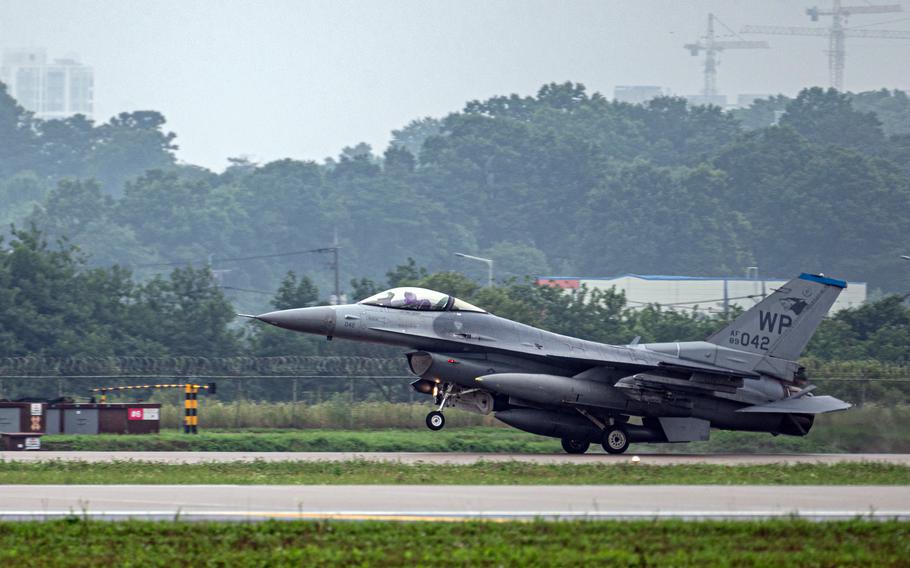
An Air Force F-16 Fighting Falcon lands at Osan Air Base, South Korea, July 9, 2024. (Chase Verzaal/U.S. Air Force)
CAMP HUMPHREYS, South Korea — Air Force fighter jets are temporarily moving closer to North Korea to “optimize combat capability and increase readiness” on the Korean Peninsula.
Nine F-16 Fighting Falcons from the 8th Fighter Wing at Kunsan Air Base, roughly 115 miles southwest of Seoul, will be assigned for a yearlong trial to the 36th Fighter Squadron at Osan Air Base, about 30 miles south of the capital, according to an Air Force news release Thursday.
The F-16s began arriving at Osan earlier this month, 7th Air Force spokesman Maj. Rachel Buitrago told Stars and Stripes by phone Monday. Two fighter squadrons of F-16s and A-10 Thunderbolt IIs are permanently stationed at the base.
“This test is an opportunity for us to see if squadrons of this size increase our training effectiveness while also increasing our combat capability if deterrence fails,” 7th Air Force commander Lt. Gen. David Iverson said in the release.
Around 150 service members will be moving to Osan, home of the 7th Air Force, as part of the trial, according to the release. The 36th Fighter Squadron will have 31 aircraft with the F-16s from Kunsan.
The 7th Air Force mission is to deter aggression and maintain the armistice in place between North Korea, China and the former Soviet Union on one side and the U.S., South Korea and United Nations Command on the other. The armistice signed 71 years ago this month stopped the fighting, but the war technically has not ended, because a peace agreement was not reached.
Airpower overflights by the U.S. and South Korean air forces have served as a response to North Korean missile tests and other demonstrations.
Four F-16s from the fighter squadron flew over international waters alongside two Japanese F-2s on June 20 as part of broader aerial drill in the region, according to a 51st Fighter Wing news release that day.
Roughly 30 F-16s from the 8th Fighter Wing temporarily relocated to Osan for six months last year due to routine repairs on Kunsan’s runway. The $22 million project to replace over 1,500 concrete slabs was completed in August.
The most recent relocation follows a series of U.S fighter jets moves in Japan.
A squadron of F-35C Lightning IIs will replace one composed of F/A-18 Super Hornets in Carrier Air Wing 5 based at Marine Corps Air Station Iwakuni, according to a Navy news release on July 15.
The Air Force this month also announced the permanent deployment of 36 F-15EX Eagles to Okinawa to replace 48 F-15C/Ds. Another 48 F-35As are going to Misawa to replace 36 F-16s, the Air Force said in the same announcement July 4.
Pacific Air Forces released a report in September citing a need to revamp its programs for deployed aircraft to minimize response times for crises and deter threats from China, North Korea and Russia.
“Our current basing posture, optimized seventy years ago, adversely affects our ability to rapidly respond to natural disasters and man-made crises today,” the report said. “PACAF is expanding access, basing, and overflight to include distributed operations in new strategic locations.”